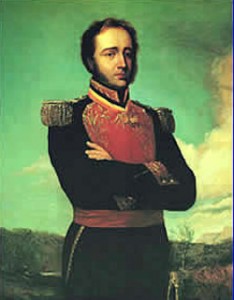Ladies and Gentlemen, I am here today to tell you all the story of the life of one of the most original men with such an unoriginal name: Gregor MacGregor.

Gregor MacGregor was one of the greatest con men in history, amassing over £1.3 million in bond-market frauds over his lifetime (1786-1845), which would be about £3.6 billion today.
What was MacGregor’s trick to swindling so many people in the early nineteenth century? Upon returning to London in 1820 after an eight-year stint in the Americas, Gregor MacGregor invented a country.
But let’s set the story up properly with some background on our hero. When he was 16, Gregor joined the British army and was seconded (lent) to the Portuguese army where he fought
against Spain before sailing across the Atlantic in 1812 in search of adventure. He landed in Venezuela and joined with Simón Bolívar’s freedom fighters, later marrying Bolívar’s cousin. MacGregor worked his way up to the rank of brigadier general in the Venezuelan republican army after he organized a mass escape through a Spanish siege thanks to a French privateer while fighting for Colombian independence. MacGregor captured Amelia Island off the coast of Spanish Florida with a small force funded by wealthy Americans. These Indiana Jones-esque adventures are all the things he didn’t make up!
Upon his return to London with his wife in 1820, MacGregor started a whole different kind of adventure. He claimed that a Native American king had named him the “cazique” – or Prince – of “Poyais,” a land located near the Black River in modern-day Honduras. MacGregor claimed Poyais, an entirely fictional nation, covered eight million acres and was rich in natural resources but in need of development. That would require both cash and manpower. MacGregor persuaded people not only to invest their savings in the bonds of a non-existent government, but also convinced 250 people to emigrate to Poyais.
How did he accomplish this? Part of his success was due to his brilliant salesmanship. MacGregor got his interviews in the national papers, he wrote and published a book under a false name which confirmed MacGregor’s promises of friendly natives and plenty of natural resources. Another part of his success was due to the chaotic financial markets of the time, where foreign government debt offered a higher rate of return which attracted greedy investors who didn’t take the time to double-check MacGregor’s claims.
In late 1822 two ships carried around 250 settlers – including a banker, doctors, and military commanders – across the Atlantic to Poyais. On arrival, they found no port, no town and no roads. At first, they thought they must be in the wrong place. But the settlers stayed and tried to make the best of it. This didn’t work out. Six months later, a passing ship saw their camp and rescued the remaining settlers. Two-thirds of the “Poyers” (as the settlers liked to be called) had died. Word of all this reached London and the British Navy intercepted the five other boats that had already set sail. By the time that authorities tried tracking down MacGregor, he had already fled to France.
Once MacGregor landed in France, he set about constructing the exacting same scheme, raising money from rich creditors in exchange for Poyais government bonds, and convincing 60 French settlers to get on a boat to sail to the fictional country. However, the French government grew suspicious when they received 60 passport filings for travel to a fictional country. The government stopped the ship in the harbor when it was already full of would-be settlers. Once word got out that the Prince of Poyais was a fraud, MacGregor went into hiding but was caught and imprisoned. He stood trial for fraud in a French court along with his financial partners from the banks. What happened next? MacGregor was acquitted! He beat the charge!
Sensing that he’d better get the hell out of dodge, MacGregor sailed back over to Scotland where a few years later he tried to sell even more people on the idea of Poyais! It didn’t work this time. So what did Gregor do? He sailed back to Venezuela where he was made a citizen, reinstated as a general, received a military pension appropriate for an officer of his rank, and died in relative comfort.
After reading about MacGregor for a while, I actually started rooting for him. He’s a scoundrel, but he’s my scoundrel … like Han Solo but with South American independence movements instead of the Rebel Alliance. Why shouldn’t he be allowed to swindle some stuffy London aristocrats out of their money? Screw those imperialists!
But then I remembered that he conned 250 people into sailing halfway across the world on false promises and that all but 60 of the settlers died before rescue.
Alas, history has all but forgotten Gregor MacGregor. He pulled what is possibly the greatest swindle of all time, multiple times, and his story has single-handedly made me believe that anyone can accomplish great things in life with just a little imagination and no regard for human life.
SOURCES:
The Land That Never Was by David Sinclair (Da Capo Press, 2004) – Available on Amazon
http://www.economist.com/news/christmas-specials/21568583-biggest-fraud-history-warning-professional-and-amateur-investors
http://www.cracked.com/article_15892_the-5-ballsiest-con-artists-all-time.html